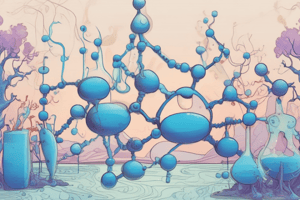Podcast
Questions and Answers
What is the primary reagent for the hydrogenation reaction of aldehydes and ketones according to the notes?
What is the primary reagent for the hydrogenation reaction of aldehydes and ketones according to the notes?
- Sodium amalgam
- Hydrogen cyanide (correct)
- Sodium bisulfite
- Grignard reagent
Which reaction type involves the addition of ammonia in the presence of a catalyst?
Which reaction type involves the addition of ammonia in the presence of a catalyst?
- Sodium bisulfite addition
- Ammonia addition (correct)
- Cyanohydrin formation
- Grignard reagent addition
What does the addition of hydrogen cyanide (HCN) produce in these reactions?
What does the addition of hydrogen cyanide (HCN) produce in these reactions?
- Ethanol
- Cyanohydrins (correct)
- Aldehyde
- Acetaldehyde
Which functional group is specifically mentioned in the context of the provided notes?
Which functional group is specifically mentioned in the context of the provided notes?
What is the purpose of using Grignard reagents in the reactions of aldehydes and ketones?
What is the purpose of using Grignard reagents in the reactions of aldehydes and ketones?
Flashcards
Hydrogenation of Aldehydes/Ketones
Hydrogenation of Aldehydes/Ketones
Adding hydrogen atoms to an aldehyde or ketone, usually using sodium amalgam (Na/Hg) or a similar reagent.
Ammonia Addition
Ammonia Addition
Ammonia (NH₃) adds to aldehydes and ketones, often with a catalyst.
Cyanohydrin Formation
Cyanohydrin Formation
Hydrogen cyanide (HCN) adds to aldehydes and ketones, forming cyanohydrins.
Sodium Bisulfite Addition
Sodium Bisulfite Addition
Signup and view all the flashcards
Grignard Reagent Addition
Grignard Reagent Addition
Signup and view all the flashcards




